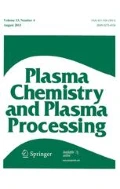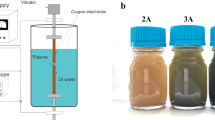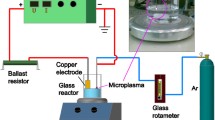Abstract
Metal oxide nanomaterials, including copper oxide, have attracted great attention due to their unique physical and chemical properties that are dependent on particle size and morphology. In this study, we propose an alternative technique for the synthesis of 2D mesoporous CuO agglomerates that is both efficient and ecological. This technique is based on the use of pulsed spark discharges between copper electrodes immersed in deionized water. Detailed TEM analyses show that the synthesized CuO nanostructures are composed of elementary nanocrystals with sizes in the order of a few nanometers. Assessments of the effects of applied voltage (5 and 20 kV) and discharge pulse width (100 and 500 ns) demonstrate that the latter parameter influences the size and density of nanocrystals in a nanostructure. Moreover, voltage and pulse width may both be used to finely control the direct optical band gap energy of CuO nanostructures between 3.0 and 3.4 eV. The efficient and ecological technique developed in this study produces 2D mesoporous CuO agglomerates that can be readily used in other processes.








Similar content being viewed by others
References
Yu X, Marks TJ, Facchetti A (2016) Metal oxides for optoelectronic applications. Nat Mater 15(4):383–396
Feng Y, Jiang X, Ghafari E, Kucukgok B, Zhang C, Ferguson I, Lu N (2018) Metal oxides for thermoelectric power generation and beyond. Adv Compos Hybrid Mater 1(1):114–126
Yang Y, Niu S, Han D, Liu T, Wang G, Li Y (2017) Progress in developing metal oxide nanomaterials for photoelectrochemical water splitting. Adv Energy Mater 7(19):1700555
Ray C, Pal T (2017) Recent advances of metal–metal oxide nanocomposites and their tailored nanostructures in numerous catalytic applications. J Mater Chem A 5(20):9465–9487
Stankic S, Suman S, Haque F, Vidic J (2016) Pure and multi metal oxide nanoparticles: synthesis, antibacterial and cytotoxic properties. J Nanobiotechnol 14(1):73
Zhang X, Dong CL, Diao Z, Lu YR, Shen S (2019) Identifying the crystal and electronic structure evolution in tri-component transition metal oxide nanosheets for efficient electrocatalytic oxygen evolution. EcoMat 1(1):e12005
Vayssieres L (2004) On the design of advanced metal oxide nanomaterials. Int J Nanotechnol 1(1–2):1–41
Mei J, Liao T, Kou L, Sun Z (2017) Two-dimensional metal oxide nanomaterials for next-generation rechargeable batteries. Adv Mater 29(48):1700176
Zhu S, Li J, Deng X, He C, Liu E, He F, Shi C, Zhao N (2017) Ultrathin-nanosheet-induced synthesis of 3D transition metal oxides networks for lithium ion battery anodes. Adv Function Mater 27(9):1605017
Zheng M, Tang H, Li L, Hu Q, Zhang L, Xue H, Pang H (2018) Hierarchically nanostructured transition metal oxides for lithium-ion batteries. Adv Sci 5(3):1700592
Wang Y, Lany S, Ghanbaja J, Fagot-Revurat Y, Chen YP, Soldera F, Horwat D, Mucklich F, Pierson JF (2016) Electronic structures of Cu2O, Cu4O3, and CuO: a joint experimental and theoretical study. Phys Rev B 94(24):245418
Kazimierczuk T, Fröhlich D, Scheel S, Stolz H, Bayer M (2014) Giant Rydberg excitons in the copper oxide Cu2O. Nature 514(7522):343–347
Boltaev GS, Ganeev RA, Krishnendu PS, Zhang K, Guo C (2019) Nonlinear optical characterization of copper oxide nanoellipsoids. Sci Rep 9(1):1–8
Heinemann M, Eifert B, Heiliger C (2013) Band structure and phase stability of the copper oxides Cu2O, CuO, and Cu4O3. Phys Rev B 87(11):115111
Rhodin TN Jr (1950) Low temperature oxidation of copper. I. Physical mechanism. J Am Chem Soc 72(11):5102–5106
Yang JC, Kolasa B, Gibson JM, Yeadon M (1998) Self-limiting oxidation of copper. Appl Phys Lett 73(19):2841–2843
Kaur M, Muthe KP, Despande SK, Choudhury S, Singh JB, Verma N, Yakhmi JV (2006) Growth and branching of CuO nanowires by thermal oxidation of copper. J Cryst Growth 289(2):670–675
Xiang L, Guo J, Wu C, Cai M, Zhou X, Zhang N (2018) A brief review on the growth mechanism of CuO nanowires via thermal oxidation. J Mater Res 33(16):2264–2280
Anandan S, Wen X, Yang S (2005) Room temperature growth of CuO nanorod arrays on copper and their application as a cathode in dye-sensitized solar cells. Mater Chem Phys 93(1):35–40
Nerle U, Rabinal MK (2013) Thermal oxidation of copper for favorable formation of cupric oxide (CuO) semiconductor. IOSR J Appl Phys 5(1):1–7
Altaweel A, Filipič G, Gries T, Belmonte T (2014) Controlled growth of copper oxide nanostructures by atmospheric pressure micro-afterglow. J Cryst Growth 407:17–24
Altaweel A, Gries T, Migot S, Boulet P, Mézin A, Belmonte T (2016) Localised growth of CuO nanowires by micro-afterglow oxidation at atmospheric pressure: investigation of the role of stress. Surf Coat Technol 305:254–263
Bayansal F, Kahraman S, Çankaya G, Çetinkara HA, Güder HS, Çakmak HM (2011) Growth of homogenous CuO nano-structured thin films by a simple solution method. J Alloy Compd 509(5):2094–2098
Dong TY, Chen CN, Cheng HY, Chen CP, Jheng NY (2011) Controlled morphologies of copper oxide single crystalline nanostructures by wet chemistry and thermal decomposition processes. Inorg Chim Acta 367(1):158–165
Volanti DP, Keyson D, Cavalcante LS, Simões AZ, Joya MR, Longo E, Souza AG (2008) Synthesis and characterization of CuO flower-nanostructure processing by a domestic hydrothermal microwave. J Alloy Compd 459(1–2):537–542
Prathap MA, Kaur B, Srivastava R (2012) Hydrothermal synthesis of CuO micro-/nanostructures and their applications in the oxidative degradation of methylene blue and non-enzymatic sensing of glucose/H2O2. J Colloid Interface Sci 370(1):144–154
Allam NK, Grimes CA (2011) Electrochemical fabrication of complex copper oxide nanoarchitectures via copper anodization in aqueous and non-aqueous electrolytes. Mater Lett 65(12):1949–1955
Sarkar DK, Zhou XJ, Tannous A, Leung KT (2003) Growth mechanisms of copper nanocrystals on thin polypyrrole films by electrochemistry. J Phys Chem B 107(13):2879–2881
Gou L, Murphy CJ (2003) Solution-phase synthesis of Cu2O nanocubes. Nano Lett 3(2):231–234
Chang Y, Teo JJ, Zeng HC (2005) Formation of colloidal CuO nanocrystallites and their spherical aggregation and reductive transformation to hollow Cu2O nanospheres. Langmuir 21(3):1074–1079
Velusamy T, Liguori A, Macias-Montero M, Padmanaban DB, Carolan D, Gherardi M, Mariotti D (2017) Ultra-small CuO nanoparticles with tailored energy-band diagram synthesized by a hybrid plasma-liquid process. Plasma Processes Polym 14(7):1600224
Belmonte T, Hamdan A, Kosior F, Noël C, Henrion G (2014) Interaction of discharges with electrode surfaces in dielectric liquids: application to nanoparticle synthesis. J Phys D Appl Phys 47(22):224016
Hamdan A, Noël C, Ghanbaja J, Belmonte T (2014) Comparison of aluminium nanostructures created by discharges in various dielectric liquids. Plasma Chem Plasma Process 34(5):1101–1114
Kabbara H, Ghanbaja J, Noël C, Belmonte T (2018) Synthesis of copper and zinc nanostructures by discharges in liquid nitrogen. Mater Chem Phys 207:350–358
Glad X, Profili J, Cha MS, Hamdan A (2020) Synthesis of copper and copper oxide nanomaterials by electrical discharges in water with various electrical conductivities. J Appl Phys 127(2):023302
Hamdan, A. (2013). Microdécharges dans l’heptane liquide: caractérisation et applications au traitement local des matériaux et à la synthèse de nanomatéraux (Doctoral dissertation, Université de Lorraine)
Hamdan A, Marinov I, Rousseau A, Belmonte T (2013) Time-resolved imaging of nanosecond-pulsed micro-discharges in heptane. J Phys D Appl Phys 47(5):055203
Trad M, Nominé A, Tarasenka N, Ghanbaja J, Noël C, Tabbal M, Belmonte T (2019) Synthesis of Ag and Cd nanoparticles by nanosecond-pulsed discharge in liquid nitrogen. Front Chem Sci Eng 13(2):360–368
Su D, Xie X, Dou S, Wang G (2014) CuO single crystal with exposed 001 facets-A highly efficient material for gas sensing and Li-ion battery applications. Sci Rep 4:5753
Liu J, Jin J, Deng Z, Huang S-Z, Hua Z-Y, Wang L, Wang C, Chen L-H, Li Y, Van Tendeloo G, Su B-L (2012) Tailoring CuO nanostructures for enhanced photocatalytic property. J Colloid Interface Sci 384(1):1–9
Chang Y, Zeng HC (2004) Controlled synthesis and self-assembly of single-crystalline CuO nanorods and nanoribbons. Cryst Growth Des 4(2):397–402
Herbani Y, Nasution RS, Mujtahid F, Masse S (2018) Pulse laser ablation of Au, Ag, and Cu metal targets in liquid for nanoparticle production. In: Journal of Physics: Conference Series, vol 985, no 1, pp 012005. IOP Publishing
Kazakevich PV, Voronov VV, Simakin AV, Shafeev GA (2004) Production of copper and brass nanoparticles upon laser ablation in liquids. Quantum Electron 34(10):951
Mohan S, Singh Y, Verma DK, Hasan SH (2015) Synthesis of CuO nanoparticles through green route using Citrus limon juice and its application as nanosorbent for Cr (VI) remediation: process optimization with RSM and ANN-GA based model. Process Saf Environ Prot 96:156–166
Bouazizi N, Bargougui R, Oueslati A, Benslama R (2015) Effect of synthesis time on structural, optical and electrical properties of CuO nanoparticles synthesized by reflux condensation method. Adv Mater Lett 6(2):158–164
Zhu J, Chen H, Liu H, Yang X, Lu L, Wang X (2004) Needle-shaped nanocrystalline CuO prepared by liquid hydrolysis of Cu (OAc)2. Mater Sci Eng A 384(1–2):172–176
Son DI, You CH, Kim TW (2009) Structural, optical, and electronic properties of colloidal CuO nanoparticles formed by using a colloid-thermal synthesis process. Appl Surf Sci 255(21):8794–8797
Dagher S, Haik Y, Ayesh AI, Tit N (2014) Synthesis and optical properties of colloidal CuO nanoparticles. J Lumin 151:149–154
Zhao J, Liu R, Hua Z (2015) Hydrothermal synthesis and optical properties of single crystalline CuO nanosheets. Superlattices Microstruct 81:243–247
Wang L, Zhou Q, Zhang G, Liang Y, Wang B, Zhang W, Lei B, Wang W (2012) A facile room temperature solution-phase route to synthesize CuO nanowires with enhanced photocatalytic performance. Mater Lett 74:217–219
Acknowledgements
The authors thank the Fonds de Recherche du Québec–Nature et Technologie (FRQ-NT) and the Canada Foundation for Innovation (CFI) for funding the research infrastructure. This project has received funding from the European Union’s Horizon 2020 research and innovation programme under Grant Agreement No 823717–ESTEEM3.
Author information
Authors and Affiliations
Corresponding authors
Additional information
Publisher's Note
Springer Nature remains neutral with regard to jurisdictional claims in published maps and institutional affiliations.
Rights and permissions
About this article
Cite this article
Hamdan, A., Agati, M. & Boninelli, S. Selective Synthesis of 2D Mesoporous CuO Agglomerates by Pulsed Spark Discharge in Water. Plasma Chem Plasma Process 41, 433–445 (2021). https://doi.org/10.1007/s11090-020-10126-7
Received:
Accepted:
Published:
Issue Date:
DOI: https://doi.org/10.1007/s11090-020-10126-7




